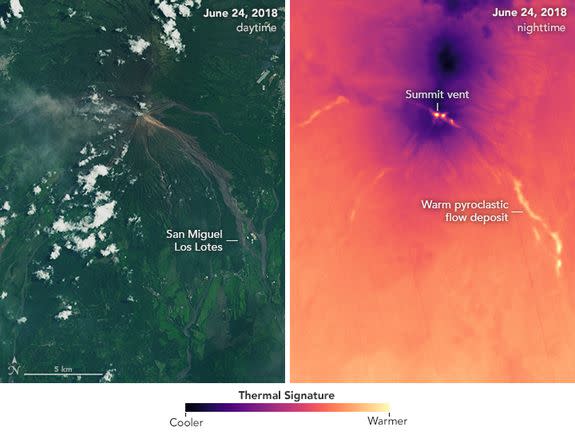NASA finds Fuego's volcanic avalanches are still warm, weeks after violent eruption

A NASA satellite passed over Guatemala's Volcán de Fuego on June 24, and it found something intriguing.
According to data collected by the satellite — named Landsat 8 — temperatures in the chaotic avalanches the volcano blasted down its flanks three weeks earlier are still relatively high.
Landsat 8 takes around 400 detailed images each day, and can also measure thermal conditions on the ground, leading to this finding at Fuego.
SEE ALSO: Something much weirder than a ‘supervolcano’ is brewing under New England
In Landsat's recent thermal imaging, it picked up temperatures some 4 to 6 degrees Celsius (7 to 10 degrees Fahrenheit) higher than the surrounding tropical land over long portions of this still-cooling volcanic debris. The debris was left by scorching avalanches of newly-formed rock and gas — known as pyroclastic flows — which, when erupted, measured some 1,800-degrees Fahrenheit, according to NASA.
Although surface temperatures on the sand-like volcanic debris have cooled, heat deeper inside this insulated rock remains — though it has certainly diminished substantially since early June, when much of the recently erupted rock was still steaming.

Image: Nasa
"Cooling deposits can show surface temperatures above the background level for a long time — weeks, or even months," Michigan Technological University volcanologist Rüdiger Escobar-Wolf told NASA Earth Observatory.
Areas with more lingering heat can give volcanologists important information about how thick and hot the avalanches of scorching rock were, said Escobar-Wolf, providing scientists a better understanding what Fuego (and volcanoes like it) are capable of.
Fuego's pyroclastic flows pummeled the village of San Miguel Los Lotes in early June. This volcanic debris still steamed near the village three days after the avalanches entered town.
These flows of scorching rock and gas — which are far distinct from lava — often travel down a mountain's low points, channels, and valleys. San Miguel Los Lotes, unfortunately, sat inside this low elevation terrain.
The speeding avalanches also overran Hotel La Reunión Golf Resort and Residences, which sat some 5 miles away from Fuego. The resort, however, said it evacuated before debris flows sacked the verdant land.
WATCH: Ever wonder how the universe might end?


